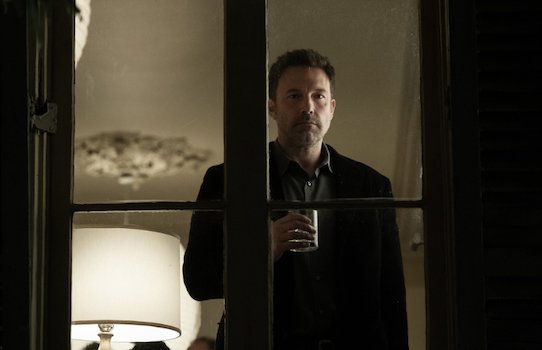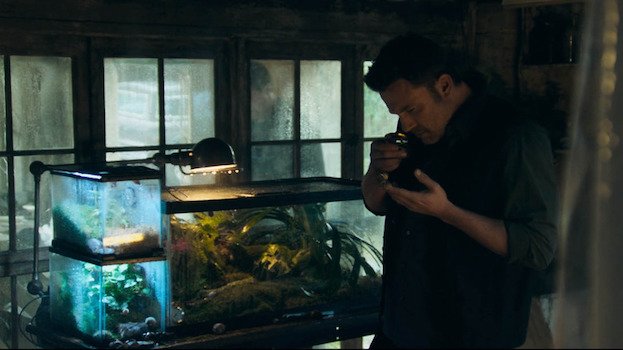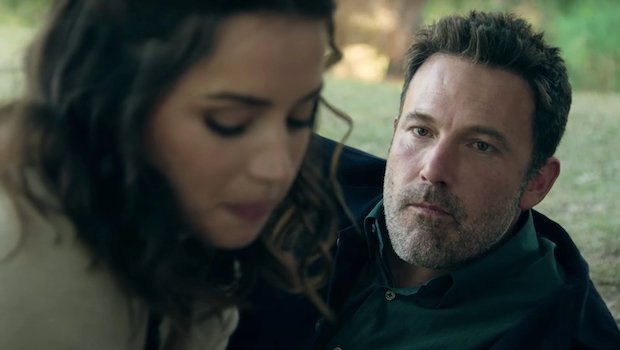Revised and Visualized: Adrian Lyne Adapts Highsmith’s “Deep Water”
SPOILERS abound.
Adrian Lyne’s “Deep Water” is that odd film which closely adapts its source novel’s plot while ignoring what the book is actually about. Patricia Highsmith’s 1957 novel and Lyne’s 2022 film wind up telling vastly different stories, but Lyne’s film hews a lot closer to the novel than do most film adaptations. Lovers of the book (myself included) can’t be too outraged by what amounts to a bastardization of the text, since for a long while Highsmith’s story and characters are more or less right there on screen. Where the film diverges from the book, the writers mostly revise existing scenes to fit the altered story, so that only a small percentage of the film’s scenes cannot be traced back to the novel. What results is a fascinating demonstration of revision: even if Lyne and screenwriters Zach Helm and Sam Levinson (or those who wrote their checks) chose a more commercial, arguably safer story than Highsmith, the film is still a valuable document for showing precisely how they did that.
Ben Affleck and Ana de Armas as the Van Allens
The novel and film begin with one of the unhappiest marriages ever depicted in fiction, between Vic Van Allen and his promiscuous wife Melinda (in the film, Ben Affleck and Ana de Armas). Any love – and, in the novel, sexual attraction – between the two disappeared years before the opening, which in both versions finds the couple at one of the many lavish parties thrown routinely in their upper-class community. At this party, the parameters of the Van Allens’ bizarre relationship are established: Melinda carries on affairs out in the open before Vic and their friends and Vic broods over it while pretending it’s all the same to him. Vic’s stoic exterior is rather brittle: he is single-mindedly focused on Melinda and her lover, and even tries to scare off his rival by lying that he murdered one of Melinda’s past boyfriends. The yawning gap between how Vic sees himself and his true, dark interior is the central fascination of the novel. Highsmith’s Vic has no sexual interest in Melinda and therefore suffers no jealousy; he prides himself on his sophisticated acceptance of her affairs, yet his buried, irrational hatred of Melinda and her lovers ultimately drives him to murder. One facet of Highsmith’s genius was her ability to convincingly render a broken psyche: there isn’t one single reason Vic eventually cracks, and for all his flaunted self-knowledge, he couldn’t explain it himself. There are, however, a few clear motivating factors, and this is where the film begins to differ from the book.
A large part of that difference is the result of Lyne and his writers’ choice to refashion the story into a sexy thriller ala Lyne’s Fatal Attraction or Unfaithful. On the page, there isn’t much to justify this choice: Vic is creepily asexual, and since the narration sticks entirely to his point of view, Melinda’s affairs are only ever implied. The screenwriters’ solution is predictable: Vic, no longer asexual, is now consumed with lust for Melinda, justifying a lot of sexual tension between the leads. This is a simple change with a complicated effect on the story. Highsmith’s primary interest is Vic’s fractured identity. Consciously, he is not possessive of Melinda and sees their open marriage as a kind of progressive innovation, but he loses control to a deeper, darker and less rational side of himself. A Vic motivated by conscious sexual jealousy is a more cohesive Vic, and thus the intricate psychological portrait that forms the heart of Highsmith’s novel is thrown out. Also, the addition of Vic’s sexual possessiveness provides such a neat explanation for his eventual breakdown that the character’s other motivations become basically irrelevant. This could explain the change in setting from Highsmith’s stuffy 1950s New England to the present-day New Orleans of the film. Highsmith’s Vic is invulnerable to sexual jealousy, but not to the damage done to his ego by the constant public scandal of Melinda’s affairs. Public opinion isn’t so important to Lyne’s Vic, therefore the conservative social dynamics of the 1950s are unnecessary to the film. Also, period pieces are expensive to shoot.
It’s interesting that after massive changes to the setting and protagonist the film sticks so close to the novel for its first half. Shifting Vic’s motivation away from the ambiguous malaise he suffers in the book to simple sexual jealousy transforms him into a different character, but the overall state of the Van Allens’ marriage remains the same. While the acrimonious dynamic between the two is developed, and Vic is driven closer and closer to murder, scenes from the novel are depicted almost verbatim. After Vic scares off her first lover with his “joking” threat, Melinda takes up with a restaurant pianist, whom Vic quietly stalks. Throughout these tension-building scenes, Affleck gamely realizes Highsmith’s character. On the page, Vic doesn’t come off as an Affleck type: he’s pudgy, gentle, submissive; a passive-aggressive powder keg. I can’t recall Affleck ever playing a pushover, but he does so convincingly here. Somehow, he makes his intimidating bulk seem small and unthreatening.
For a while, Vic’s lust doesn’t seem like such a huge change to the story. It’s just one extra reason among plenty for him to suffer at the hands of Melinda. I was doubtful, because of de Armas’ casting, that Highsmith’s Melinda would make it to the screen at all. In the book she’s a sour, narcissistic hedonist with no redeeming qualities, a far cry from the perfect angels de Armas played in Blade Runner 2049 and Knives Out. Much to my surprise, Lyne’s Melinda is an even more rotten character than Highsmith’s, at least for a time, and de Armas is a revelation in the role. Whereas Highsmith’s Melinda is simply indifferent to Vic, Lyne’s takes pleasure in using his unfulfilled lust to torture him. In the film, when Vic innocently dances with a friend at a party, Melinda lashes out and pettily asserts her ownership of him, an abusive response given her own unrepentant faithlessness. Bullying Vic even gets Melinda excited: it leads to the only sex scene between the two, a fraught scene where the hierarchy of their relationship is depicted bluntly. At this point it seems like the writers are using the added erotic tension to enhance the twistedness of Highsmith’s characters, rather than capitulate to something more conventional, but this is not the case.
The first hint that Lyne and his writers have chosen a softer take on these characters comes with one of the only wholly invented scenes in the first half of the film. It’s a short scene where the Van Allens attend their only daughter Trixie’s soccer game and Melinda complains that the other team has an unfair advantage. One of the ironies of the book is that although Vic is a killer with some sociopathic tendencies, he’s nevertheless a much better community member and parent than Melinda, who would never, under any circumstances, take the slightest interest in her daughter’s soccer game. Giving Melinda some investment in her daughter adds justification for the story of family reunification that the film turns out to be telling, but this is also where the fractures between the novel and film begin to show. Considering the extent to which the film preserves Highsmith’s misanthropic vision of the Van Allens, the choice to eventually sentimentalize their reconciliation feels very odd indeed.
The first actual murder takes place at the one-third point of the book and the halfway point of the film. Melinda takes that piano player to another community party and when no one is looking Vic drowns him in the backyard swimming pool. In the book, if you don’t know it’s coming, the killing happens with a disturbing suddenness that’s even surprising to Vic. In the film, Vic’s jealousy is emphasized so much that the murder feels inevitable. The immediate aftermath is handled the same in both versions: police are called, but nearly everyone at the party assumes the death was an accident, with the exception of Melinda and a suspicious grump named Don Wilson (Tracy Letts in the film). From this point on, the screenwriters are telling their own story, although they’re doing so by refashioning scenes and events from the novel.
The titular water
Highsmith, master of the slow burn, uses the remaining two thirds of her book to explore how people can inure themselves to unthinkable misery in order to prove a point. Melinda stays with Vic in the hopes of exposing his guilt, though we sense it’s as revenge for him spoiling her fun rather than out of any loyalty to the murder victim. For Vic, leaving would mean admitting the failure of what he calls his “experiment,” that being the open relationship which is, paradoxically, the bane of his existence. Though Vic is the actual murderer in this situation, Melinda is very much the aggressor; after the killing she becomes cruelly antagonistic. She takes up with Tony, an affable lunk who’s everything Vic is not, and she flaunts her infidelity more spitefully than ever.
Tony becomes Vic’s second victim, and it’s here that Highsmith acutely delineates the contradictions of Vic’s personality. Vic, who’s apparently had enough, offers Melinda a divorce, an outcome which would obviously benefit everyone involved. Melinda agrees, and when she’s just about to run away with Tony, Vic abducts Tony, kills him, and hides his body in an abandoned quarry. Tony’s disappearance has the consequence it appears Vic intended: Melinda sticks around. Why does Vic prolong his marital hell when he showed every intention of ending it? The answer is that Dostoevskian insight that as bad as things can get, some people will always choose to make them worse (the novel begins with a quote from Demons).
The murder of Tony happens about four fifths into the novel and sets about a collision course between the Van Allens. Melinda and Don eventually succeed in exposing Vic’s guilt, and when the police are on the way, Vic loses it and kills Melinda. Vic’s divided mind is described economically as he’s carrying out his final murder:
His hands closed around her throat and he shook her. The stupid terror in her open eyes made his hands tighten all the more. Then suddenly he released her. “Get up,” he said. After all, he did not want to kill her. She was coughing. “Melinda-”
Then he heard a car outside and the last barrier of his anger broke and he threw himself on her.
The novel ends with Vic arrested for his crimes. The movie, improbable though it may seem, ends with Vic and Melinda reconciled, with the implication that they will give their marriage another go. Both versions arrive at their very different endings through more or less the same series of events. My conspiracy theory regarding the film is that at some point a draft was turned in that was a closer adaptation of the book, some executive demanded a “happy” ending, and the story was minimally retro-fitted to make sense with the new conclusion. Otherwise, it’s not clear why, if the writers wanted to tell such a different story, they would preserve so much of the book’s plotting.
The movie gestures toward the compelling new directions it could take Highsmith’s story, but doesn’t really follow through. After Vic’s first murder, he asks Melinda why, if she believes he’s a killer, she’s not afraid of him. “Because I’m what you killed for,” she responds, and de Armas’ reading implies she’s turned on by this fact. If the movie versions of Vic and Melinda had to end up together, Melinda getting a perverse thrill out of Vic’s murders would have been a twist worthy of Highsmith. Exploring this side of Melinda would have been one way to set the stage for the couple’s unlikely reconciliation, but the screenwriters were evidently too careful about leaving Highsmith’s scenes intact to realize this potential. Instead, Melinda’s change of heart toward Vic happens via some quick and easy screenwriting psychology: Vic shows her an album of romantic (bad) photos he’s taken of her and, seeing how much he loves her, Melinda realizes the error of her ways and becomes the devoted wife Vic’s wanted all along. This has got to be one of the most drastic character transformations in all of fiction! I can only imagine what Highsmith would think.
Elsewhere, elements of the book make it into the film despite not really cohering with the Van Allens’ new relationship dynamic. The best example is probably the snails, which viewers of the film may be surprised it’s taken me this long to address. In both versions, Vic keeps hundreds of snails as pets in the garage that is also his bedroom. Vic’s obsession with his snails carries a lot more meaning in the book, in which whole sides of Vic’s character are left an enigma. Highsmith never explains the nature of Vic’s sexuality; his lack of interest in Melinda seems genuine, but is he just suppressing his desire for her, since it can never be realized? Is he, like Tom Ripley, a repressed homosexual? Whatever the truth is, we sense that Vic is sublimating his sexuality into his study of the snails. So much of his fascination with the molluscs stems precisely from their sexual function. Snails are hermaphroditic animals; when they couple, each partner uses both male and female sex organs. Vic observes this process with a yearning that heavily reinforces his discomfort with the traditional gender roles of his marriage. In the film, where Vic’s sexuality is as clear as it gets, the snails just register as a bizarre quirk of Vic’s and an excuse for some wild visuals.
Vic and his snails
The snails occasion one of the most painful scenes of the novel. Late in the book, when things between the Van Allens are at their worst, Melinda has Tony over for dinner and they both try to bully Vic into handing over his snails for them to cook and eat. Melinda knows how much affection Vic has for his snails, so by insisting on adding them to the menu she’s committing an act of tremendous emotional violence. Even though Vic is at this point already a murderer, the reader can’t help but feel some sympathy for him as he weakly defends his beloved pets. This scene makes it into the film, though why it does is a mystery to me. Vic’s emotional connection to the snails is hardly established, so Melinda’s threat to their lives doesn’t communicate much besides a slight insensitivity on her part. It’s also strange including this scene in the film when, minutes later, the Van Allens are renewing their affection over a romantic picnic. The best explanation, again, is that this scene is refuse from an earlier draft in which Highsmith’s story was accurately depicted.
One of the most ambiguous and disturbing scenes from the novel is included despite entirely contradicting the new direction of the film. After killing Tony, Vic “celebrates” by sharing a glass of wine with… his daughter. Who is about six years old. It’s a sign that Vic is truly cracking up, and even, perhaps, a suggestion of a darker side to Vic’s feelings for his daughter. Melinda sees them drinking and chides Vic, but does nothing to stop it and is clearly indifferent to the welfare of her child. This scene is perfectly consistent with Highsmith’s dark conception of her characters, but that it is included word-for-word in the film is impossible to comprehend. Shortly after this depiction of remarkable parental misconduct, the audience is supposed to buy that Melinda is invested in her family, and even believe that something positive is happening when that family remains intact.
The aforementioned picnic appears in both versions, but in entirely different contexts. Chronologically, it occurs after Vic murders Tony, and it takes place at the same quarry where Vic hid Tony’s body. In the novel, when Tony disappears, Melinda and Don suspect right away that Vic has killed him. Months pass, during which Melinda appears to change her mind about Vic. When she invites him to that romantic picnic by the quarry, we realize in hindsight it’s as a ploy by her and Don to have Vic slip up in some way and reveal his guilt. The ploy succeeds: Vic sees Tony’s body has partly emerged from the quarry’s (not-so-deep) water, and when Vic returns the next day to re-dispose of the evidence, Don is waiting to catch him in the act. In the film this all goes down in much the same way but with one major difference: Melinda has truly rediscovered her affection for Vic. Therefore, Melinda’s suggestion to have a picnic at the exact sight of Tony’s murder is a pure coincidence, as is Don’s appearance there the next day when Vic tries to hide the body. It’s curious why, since the outcome is so different, the screenwriters didn’t change the climax to make it fit their new story. They weren’t exactly obligated to include the exact scenes of Highsmith’s text; a brand-new sequence of events could have made a lot more sense. One gets the impression that the writers only had a half hour to add that happy ending, so they made quick little changes here and there instead of adequately redesigning the story.
The crucial picnic
On the other hand, given that the new ending is a demonstration of what the writers do when they’re starting from scratch, perhaps it’s best they stuck with Highsmith’s text for so long. Once Don catches Vic with Tony’s body, everything that follows is wholly invented for the film. Don promises to expose Vic and drives off in his SUV, setting up the dumbest chase scene this writer has ever seen. Vic chases Don’s SUV… on his bicycle. And for a while he keeps up. Even if Affleck were suited up as Batman, this would be hard to believe. Meanwhile, Don loses control of his SUV because he can’t help himself from hysterically texting his wife (Letts’ performance here is amusing despite the stupidity of what he’s asked to do). It turns out that phone-addiction is Don Wilson’s fatal character flaw; he’s so focused on texting that he drives himself off a cliff.
The chase is intercut with scenes of Melinda at home, where she is suddenly and inexplicably struck with suspicion, investigates Vic’s room and finds Tony’s wallet hidden with the snails (why did Vic keep the wallet? So Melinda would find it, of course). Melinda packs some luggage, but her daughter objects to leaving Vic. This is all it takes to convince Melinda that her and her daughter are better off staying with a double murderer, so when Vic returns after that chase, Melinda communicates to him that she both A) knows about Tony and B) has accepted it. The film ends with a shot of Tony’s wallet burning, the implication being that Melinda is burning the evidence to protect her family (there’s still that body floating in the quarry, but that’s a minor detail).
So we end up with a conclusion virtually identical to that of Lyne’s Unfaithful. On its face, there’s nothing wrong with turning Highsmith’s psychologically rich novel into a sleazy Hollywood thriller. I doubt filmmakers were lining up to shoot a true adaptation of the book, so a version like this is probably the best a Highsmith fan could expect. Still, there’s something about the revision here that strikes me as lazy. It’s not shocking that the filmmakers and/or producers didn’t want to end their movie with its beautiful leading lady strangled to death, but they were smart enough to understand that changing the ending would have ramifications on the rest of narrative. Their new take on these characters could have made sense with a little more revision to the bulk of the story. The appearance is that the writers deferred to Highsmith for so long not because of her genius, but to save themselves the effort of writing anything new. And as happy endings go, I’m not sure even the most low-brow normie would cheer for a reunion between a double murderer and a terrible mother, sexy though they may be. The ending is so cynically conventional it’s actually perverse, but not intriguingly so. Ironically, it’s a shame Lyne and his writers remained so faithful to Highsmith, when it would have suited them better to cheat a little.





